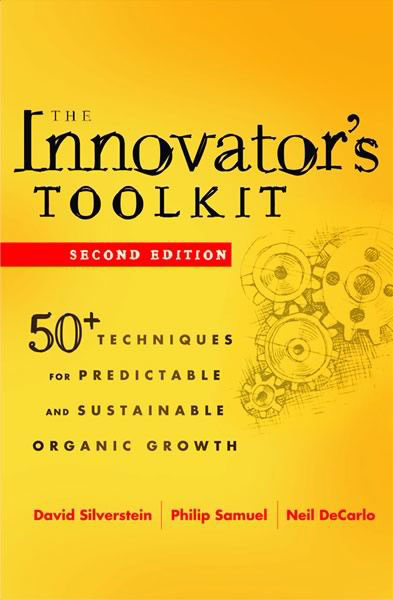The
Innovator's
Toolkit
50+ Techniques for Predictable and Sustainable Organic Growth
Buy on Amazon Buy on Barnes & Noble
50+ Techniques for Predictable and Sustainable Organic Growth
Buy on Amazon Buy on Barnes & Noble
Humans have been innovating since before…well…just about everything. In fact, our ability to innovate is, in large part, what makes us human. Yet for all of our success and experience, we still have little actual knowledge of the innovation process. The Innovator’s Toolkit changes that by providing a step-by-step guide to systematic, repeatable, reliable innovation.
Following years of research by their team of more than 20 researchers, Samuel, Silverstein and DeCarlo draw upon the entire team’s personal experiences and insights as well as best-in-class research from people like Clayton Christensen of the Harvard Business School, Eric von Hippel of MIT, Edward de Bono, Michael Kirton, George Land, and many others.
While these many brilliant minds have codified elements of the process by which humans innovate, the Innovator’s Toolkit offers the first systematic approach that can be referred to as a methodology, not merely a set of tools.
The authors’ D4 Process (Design, Discover, Develop, Demonstrate) enables individuals and teams to follow a step-by-step process, drawing upon proven tools and approaches, while still encouraging the freedom of thought that is ultimately at the heart of all innovation.
Request a free copy of the Introductory Chapter
| Exhibit # | Title | Page # | |
|---|---|---|---|
| Exhibit 1.3 | Structure of a Job Statement | 10 | Download |
| Exhibit 1.4 | JTBD Prioritization | 11 | Download |
| Exhibit 3.1 | Outcome Expectations | 21 | Download |
| Exhibit 3.2 | Opportunity Prioritization | 25 | Download |
| Exhibit 7.2 | Problem Statement Prioritization Matrix | 54 | Download |
| Exhibit 8.1 | Nine Windows Architecture | 58 | Download |
| Exhibit 8.2 | Nine Windows Solution Ideas | 62 | Download |
| Exhibit 9.1 | Job Scoping | 65 | Download |
| Exhibit 10.1 | Stakeholder Diagnostic | 70 | Download |
| Exhibit 10.2 | Power and Influence Map | 71 | Download |
| Exhibit 10.3 | Leverage Matrix | 73 | Download |
| Exhibit 12.1 | Innovation Project Charter | 84 | Download |
| Exhibit 13.2 | Initial Assumptions | 93 | Download |
| Exhibit 13.3 | Reverse Income Statement | 94 | Download |
| Exhibit 13.4 | Pro Forma Operations Specs | 94 | Download |
| Exhibit 13.5 | Updated Income Statement | 95 | Download |
| Exhibit 13.6 | Milestones and Assumptions | 97 | Download |
| Exhibit 15.3 | Functional Analysis and Trimming Worksheet | 113 | Download |
| Exhibit 17.2 | Creative Challenge Matrix | 128 | Download |
| Exhibit 18.1 | HIT Matrix | 132 | Download |
| Exhibit 19.1 | SCAMPER Guidelines and Example | 135 | Download |
| Exhibit 20.1 | Brainwriting 6-3-5 | 139 | Download |
| Exhibit 21.1 | Imaginary Brainstorming | 142 | Download |
| Exhibit 24.1 | Provocation and Movement | 156 | Download |
| Exhibit 26.3 | Contradiction Matrix Cross Section | 170 | Download |
| Exhibit 31.1 | Idea Sorting—Before | 200 | Download |
| Exhibit 31.2 | Idea Sorting—After | 202 | Download |
| Exhibit 31.3 | Idea Refinement—Operationalize the Idea | 203 | Download |
| Exhibit 31.4 | Idea Refinement—Reinforce the Idea | 204 | Download |
| Exhibit 33.1 | Functional Requirements | 220 | Download |
| Exhibit 36.1 | Morphological Matrix | 238 | Download |
| Exhibit 36.2 | Morphological Matrix Design Concepts | 239 | Download |
| Exhibit 36.3 | Another Morphological Matrix Example | 240 | Download |
| Exhibit 37.1 | TILMAG Matrix | 243 | Download |
| Exhibit 37.2 | TILMAG Design Concepts | 244 | Download |
| Exhibit 40.1 | Pugh Matrix Example | 259 | Download |
| Exhibit 43.1 | Overall Performance Scorecard | 276 | Download |
| Exhibit 43.3 | Overall Component Scorecard | 280 | Download |
| Exhibit 43.4 | Component Scorecard | 281 | Download |
| Exhibit 43.5 | Overall Process Scorecard | 282 | Download |
| Exhibit 43.6 | Process Scorecard | 283 | Download |
| Exhibit 44.1 | Design FMEA | 287 | Download |
| Exhibit 44.2 | Severity of Effect | 288 | Download |
| Exhibit 44.3 | Likelihood of Occurrence | 289 | Download |
| Exhibit 44.4 | Likelihood that Control Will Detect or Prevent Failure | 290 | Download |
| Exhibit 48.1 | Function Audit | 320 | Download |
| Exhibit 49.1 | Pilot Charter | 324 | Download |
| Exhibit 50.2 | SIPOC Map | 332 | Download |
| Exhibit 52.1 | Attribute MSA Worksheet | 344 | Download |
| Exhibit 52.2 | Attribute MSA Results | 345 | Download |
| Exhibit 54.1 | Conjoint Analysis Matrix | 356 | Download |
| Exhibit 54.2 | Conjoint Analysis Ratings | 357 | Download |
| Exhibit 54.3 | Conjoint Analysis Utility Score | 358 | Download |
| Exhibit 56.1 | Common Cause & Effect Diagram Categories | 369 | Download |
| Exhibit 57.1 | Cause & Effect Matrix | 372 | Download |
| Exhibit 58.1 | Control Plan | 376 | Download |
